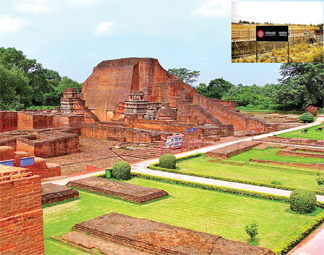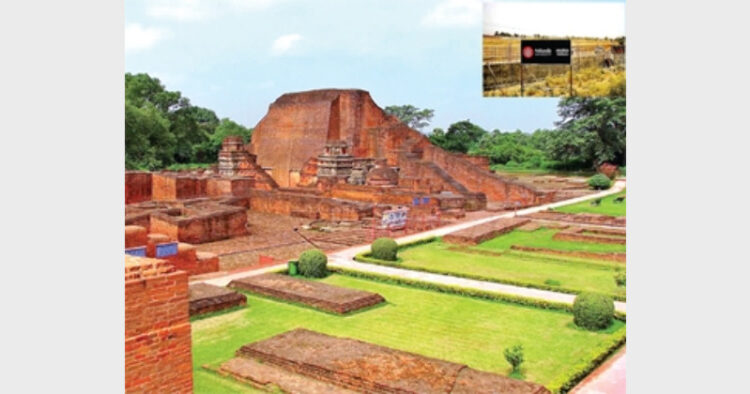 Intro: Established in the fifth century during the Gupta dynasty, the ancient Nalanda University was home to thousands of scholars and thinkers from across the world. After 817 years of its destruction by the Turkish army, the old school is being revived to aware the world about India’s intellectual prowess and ancient wisdom.?
Intro: Established in the fifth century during the Gupta dynasty, the ancient Nalanda University was home to thousands of scholars and thinkers from across the world. After 817 years of its destruction by the Turkish army, the old school is being revived to aware the world about India’s intellectual prowess and ancient wisdom.?
Along with the rise of Buddhism, India witnessed golden cultural era and made progress in many fields. On the contrary, when there was rise of Christian religion in Europe, the Roman Empire became wretched-schools and centres of philosophy were closed down; the renowned library at Alexandria was burnt down by a Christian mob led by their religious head; and the learned philosopher Hypatia was dragged into a Church and her flesh was torn off her body. As a consequence of these barbaric acts, Europe plunged into the darkness of ignorance and poverty for a thousand years. Church on the other hand emerged successful and managed to convert pre-Christian pagans to Christianity, and the philosophical era developed by Socrates, Plato, Aristotle, Seneca, Pliny and others lost its sheen.
In contrast to the above event, with the rise of Buddhism in India, many centres of learning were opened. Such institutes or varsities never existed before any where in the world. Their locations indicating current geographical places were—Bihar (Nalanda, Vikramashila, Odantapuri); Bengal (Jagaddala); Bangladesh (Sompura); Odisha (Pushpagiri); Pakistan (Takshashila); Kashmir (Sharada); Gujarat (Vallabhi); Uttar Pradesh (Varanasi); Andhra Pradesh (Nagarjunakonda); Tamil Nadu (Kanchipuram);Karnataka (Manyakheta); Sri Lanka (Sunetradevi Pirivena). In these universities, many students and teachers from India and outside received knowledge and education-they were examples before the world of India’s heritage, culture and civilisation. But as fate would have it, during Muslim invasions, these Universities were destroyed by the Muslim assailants.
New Nalanda University
Former President of India APJ Abdul Kalam proposed his dream project while addressing the joint session of the Bihar Vidhan Mandal for the revival of Nalanda University. The bill for the new varsity received Presidential assent on September 21, 2010 whereafter, the new Nalanda International University came into existence on November 25, 2010 after 817 years. Gopa Sabhanwal was then appointed as the first Vice Chancellor of this University in February 2011.
It is estimated that US $500 million will be required to build the facility and further around $500 million will be needed to build the infrastructure. According to recent reports, Japan and Singapore are financing US $100 million for the construction work.
Nalanda which once attracted students across the world was formally inaugurated on September 9, 2014 in its modern avatar by External Affairs Minister Sushama Swaraj. She explained that as in the past, the University would serve as a bridge of knowledge linking the country with the world.
The centre wishes to allot Rs 2,727 crore which will be spent in building a high class campus of the University in 10 years. Sushma Swaraj also supported Bihar State’s proposal to build an Airport near the site to facilitate foreign students and dignitaries.
For the inauguration, dignitaries from Singapore, Thailand, Australia, Vietnam, Germany, Japan and Laos were also present at the inaugural function.
For the construction of the new Nalanda University, Bihar government had allotted 177 hectares of land to the University. Vastu Shilpa Consultants, who designed the Varsity also won the global competition held for the best architectural design for the building in which they had to provide triple net-zero energy, water and waste strategic plan in their design plan.
All in all, it took four years to raise the varsity structure, and finally the academic session of the University commenced on September 1, 2014 with 15 students in the school of Historical Science, Environment and Ecology. Out of proposed 7 schools, two have opened, and at present there are teachers from abroad and two foreign students from Bhutan and Japan. For now, for the fifteen students, the Bihar State Tourism Development Corporation is also providing the hostel facility.
The Government of India has also constituted a Nalanda Mentor Group (NMG) under the chairmanship of Professor Amartya Sen which has representatives from Singapore, China, Japan and Thailand.
History of ancient Nalanda
The word ‘Bihar’ has come from ‘Viharas’ of Buddhist monastery that are located in the ancient Magadha. Nalanda is located about 95 km south-east of Patna and was built in 5th century AD and was further developed by Gupta, Harsha and Pala emperors.
It is recognised as the first and the oldest University of the world that came up at a time when the world was not even aware about the concept of University. And where Takshashila although built in 5th century BC did not have all the aspects of University, the Nalanda School attracted scholars from India, Tibet, China, Greece, Sri Lanka, Java, Sumatra, Korea, Indonesia, Turk and Greater Iran. In those times education was free and medium of instruction was kept Sanskrit.
Glorious accounts of the great Nalanda tradition was also given by Chinese traveller Ying. But the glory did not stay for long as Nalanda was ransacked and burnt by the Muslim invader Bhaktiyar Khilji in 1197. The destroying fire continued for 3 months and destroyed the intellectual reserve of the country.
Since Nalanda was a residential school, it housed dormitories for around 10,000 students and accommodation for 3,000 teachers. The school building was an architectural masterpiece with a lofty wall of red bricks and one gate. It had eight compounds, ten temples, many meditation halls, classrooms, lakes and parks. The library was located in a nine storeyed building named Dharmaganga with three sections of Ratnasagar, Ratnadadhi and Ratnaranjak. Ratnadadhi preserved Holy Scriptures of Pradnyaparamita and Samajaguha. Similarly, lakhs of books of every field were classified in a scientific way. This system was borrowed from the Sanskrit authority Panini.
The subjects taught in the school were Grammar, Logic, Astronomy, Astrology, Medical science, Mathematics, Vedas, Yogas, Hindu Philosophy. Every student was expected to have knowledge of Sanskrit language and weak students were sent to Java country to learn Sanskrit. Astronomical observatory was available at a height. There was a secular way of free education and no distinction based on caste, creed, religion or country was made, and oral examinations of high standard were held by Dwar Pandit (Officer at the gate).
There were two more Universities near Nalanda in Bihar-Vikramashila on north was developed on the lines of Nalanda, and Odantapuri was built 10 km away from Nalanda. Odantapuri had an educational facility for 13,000 students. Both these Universities were destroyed by Muslim invaders later.
We Indians should feel proud that India was once home to International Universities that had spread Indian culture and civilisation to many countries in Asia, Europe, Africa and elsewhere. New Nalanda varsity which is under development offers an opportunity to take lead in educating the world about India’s intellectual prowess again.
– Achyut Railkar ?(The writer is a senior Engineer who completed several projects locally and abroad)
?
?













Comments